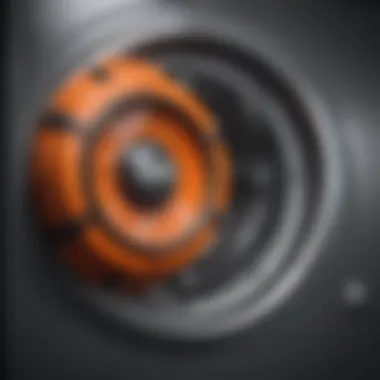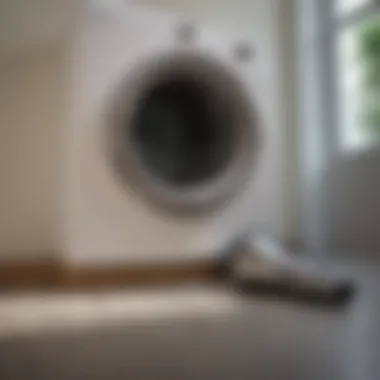Essential Guide to Vacuuming Your Dryer Vent Safely


Intro
Vacuuming out your dryer vent is a crucial maintenance task for every homeowner. Over time, lint and debris accumulate in the vent, causing blockages that can impede airflow. This not only reduces the efficiency of your dryer but also poses a fire hazard due to overheating. Ignoring this task can lead to serious consequences, making it essential to incorporate it into your regular home maintenance routine.
In this article, we will provide a step-by-step guide on how to effectively vacuum your dryer vent, covering the required tools, safety considerations, and techniques to ensure you do it correctly. We emphasize the significance of this task by outlining common issues and questions related to dryer vent maintenance, helping to empower you with the knowledge to protect your home with simple but effective actions.
Understanding the Importance of Dryer Vent Maintenance
Dryer vent maintenance is more than just a chore; it is a crucial aspect of home safety and efficiency. Many homeowners may underestimate its significance, but neglecting this essential task can lead to serious consequences. Regularly cleaning and maintaining dryer vents prevents the buildup of lint and debris, which can cause blockages. These blockages hinder airflow, resulting in longer drying times and increased energy consumption. In an era where efficiency and sustainability are at the forefront of home maintenance, this is a point worth paying attention.
The Role of Dryer Vents
Dryer vents serve a critical function in a laundry system. Their primary purpose is to expel moist air and lint generated during the drying process away from the home. Proper venting allows your dryer to perform efficiently, drying clothes effectively without excessive strain. When the dryer vent system remains unobstructed, the appliance can function as intended, minimizing energy consumption. Additionally, efficient dryer vents enhance indoor air quality by preventing humidity from lingering in the home, which can lead to mold growth.
Risks of Neglected Dryer Vents
Failing to maintain dryer vents poses considerable risks. The most alarming threat is fire. According to the U.S. Fire Administration, dryer-related fires are often ignited by lint accumulation within the venting system. Lint is highly flammable, and when the dryer works harder to exhaust the air, it can overheat and catch fire. Alongside fire hazards, other risks include:
- Energy Inefficiency: Clogged vents force the dryer to use more energy to dry clothes, leading to higher utility bills.
- Wear and Tear: The added strain on the dryer can result in expensive repairs or replacement sooner than necessary.
- Health Concerns: Excess moisture can foster mold and mildew, compromising indoor air quality and potentially affecting health.
"Regularly maintaining dryer vents can significantly reduce the likelihood of home fires and enhance appliance performance."
By understanding the importance of dryer vent maintenance, homeowners can take proactive steps to ensure safety and efficiency in their households. It is an integral part of home upkeep that should not be overlooked.
Identifying Signs of Clogged Dryer Vents
Identifying signs of clogged dryer vents is a crucial step in maintaining the efficiency and safety of your dryer. When dryer vents become obstructed, it can lead to various problems that can affect the appliance’s performance and pose significant risks. Recognizing these signs early on can help homeowners take action before the situation escalates into more serious issues.
Long Drying Times
One of the most prominent indicators of a clogged dryer vent is an increase in drying times. If clothes take longer than usual to dry, it may suggest that the airflow is restricted, causing the dryer to work harder. This not only reduces efficiency but can also lead to higher energy bills. If your clothing remains damp after a full drying cycle, it is wise to inspect the vent for any obstructions.
Burning Smells
A burning smell emanating from the dryer is a serious concern. This scent often indicates overheating, which may result from lint buildup within the vent system. This situation is not only alarming but poses a potential fire hazard. If you notice any unusual odors, it is essential to address the issue immediately. Do not ignore these warning signs, as they can lead to significant problems if left unattended.
Lint Buildup
Visual signs, particularly lint buildup, are also essential to monitor. If you find excess lint around the dryer or on the vent cover, this accumulation can indicate that airflow has been compromised. Regularly checking for lint in these areas can help maintain healthy dryer operations. Furthermore, neglecting lint buildup can lead to increased danger and inefficiency, making periodic inspections a necessary practice.
Quick Tip: Regularly clean the lint filter before or after every load to help minimize buildup in the dryer vent.
Gathering Necessary Tools and Equipment
Before embarking on the task of vacuuming out your dryer vent, it is critical to gather the necessary tools and equipment. This step sets the foundation for an effective cleaning process. Having the right tools on hand ensures that you can tackle the job efficiently and safely. It minimizes the chances of injury or damage to the vent system, which could lead to more expensive repairs.


There are different considerations when selecting tools. The primary factor is effectiveness in reaching and cleaning the various components of the vent system. Furthermore, the tools should also be compatible with the equipment you have at home.
Vacuum Cleaner Requirements
The vacuum cleaner is the essential tool for this task. It must have specific features to ensure proper suction and cleaning efficiency. Here are some key requirements to consider:
- Powerful Suction: A vacuum with strong suction capabilities is vital. A typical household vacuum might not be sufficient. Look for models designed for heavy-duty cleaning or those specifically made for dryer vents.
- Flexible Hose: The longer and more flexible the hose, the easier it will be to navigate through tight spaces. A hose that is at least 10 to 15 feet long will allow you to reach the vent without needing to move the main vacuum.
- Attachments: Specialized attachments, such as a brush or a narrow nozzle, are beneficial for reaching deep into the ductwork. These attachments help dislodge lint and other debris that could be blocking airflow.
It is essential to inspect the vacuum before use to ensure that it is in good condition and free from clogs. This creates a seamless experience when you clean your dryer vent.
Additional Tools Needed
Apart from a vacuum cleaner, several other tools can enhance the cleaning process. These tools may assist in preparing the area or facilitate a more thorough cleaning. Some of these tools include:
- Screwdriver Set: This will be essential for disconnecting the dryer from the vent. Having a set allows you to easily access screws of different sizes.
- Lint Brush: A lint brush can help gather lint from areas that are hard to reach with a vacuum. It is useful for cleaning the lint filter and the area around the dryer.
- Drop Cloths or Towels: Place drop cloths or towels around the dryer to catch any fallen lint and debris. This helps keep your space clean and reduces the risk of lint catching on anything.
- Safety Goggles and Gloves: Protecting your eyes and hands is important during this process. Safety goggles prevent lint and dust particles from irritating your eyes. Gloves also help avoid irritation from dust.
With these tools gathered, you will be well-prepared to vacuum out your dryer vent effectively. This not only improves the efficiency of your dryer but also reduces potential fire hazards.
Preparing the Area for Cleaning
Preparing the environment where you will clean your dryer vent is essential for a successful and safe process. The significance of this preparation lies in ensuring that you can work efficiently without hindrances. A clutter-free area not only aids in accessibility but also helps in minimizing the risk of accidents. Before you begin the cleaning process, thorough planning and taking necessary precautions can greatly simplify your efforts.
Safety Precautions
Safety should always be your top priority when handling any home maintenance task. Here are essential safety considerations to keep in mind:
- Unplug the Dryer: Before starting, ensure that the dryer is disconnected from the electrical outlet. This prevents any accidental activation during cleaning.
- Wear Protective Gear: Consider wearing gloves and a dust mask. These can protect against inhaling dust or lint and shield your skin from sharp edges in the vent.
- Avoid Water: Do not use water or any cleaning solution when dealing with the dryer vent. The presence of moisture can create risks of electrical shocks.
By following these basic precautions, you set a foundation for a safer work environment, reducing potential hazards.
Clearing the Space Around the Dryer
Having enough room to work is crucial. Clear the space around the dryer to ensure you can access both the machine and the vent without obstruction. Here are steps to effectively prepare the area:
- Move the Dryer: If possible, gently slide the dryer away from the wall. This allows you access to the vent duct and prevents any damage to your appliance.
- Remove Nearby Items: Take away any items that may be on, around, or behind the dryer. This includes laundry baskets, mops, or miscellaneous tools. A clean area prevents distractions and helps maintain focus on the task.
- Check for Hazards: Inspect the area for any potential hazards, like wet floors or loose cords. Eliminate these risks so that you do not encounter any accidents while working.
Taking these steps ensures that you can move freely as you clean. A well-prepared area significantly enhances efficiency and safety during the vacuuming process.
Step-by-Step Process of Vacuuming the Dryer Vent
Proper maintenance of your dryer vent is crucial for both safety and efficiency. The step-by-step process of vacuuming the dryer vent not only prevents potential fire hazards but also promotes optimal drying performance. By ensuring that the airflow is unobstructed, you minimize the risks associated with overheating and energy wastage. This section provides a clear and detailed guide to effectively vacuum your dryer vent.
Disconnecting the Dryer
The first step is to disconnect the dryer from the power source. This is a critical safety measure. Unplug the dryer from the outlet to prevent any electrical accidents while you work. If your dryer is gas-powered, turn off the gas supply as well. After disconnecting, it is advisable to move the dryer away from the wall to access the vent duct. Ensure that you have enough space to maneuvers safely around the appliance.
Accessing the Vent Duct


With the dryer moved, you can now locate the vent duct. The duct typically runs from the back of the dryer to the exterior of your home. Depending on your dryer setup, you may need to loosen clamps or unscrew sections to fully access the vent. Pay attention to the type of duct you have, as some materials might require specific handling, including flexible vinyl or metal. This step is crucial, as it allows you to inspect for any visible damage or blockages before vacuuming.
Using the Vacuum
Now that you have accessed the vent duct, it's time to use your vacuum cleaner to remove lint and debris. Equip your vacuum with a long hose attachment that can reach into the duct. Insert the hose as deep into the vent as possible while keeping a steady hand to avoid damage. Turn on the vacuum and slowly pull it back. You may need to repeat this a few times until you feel confident that most of the buildup is cleared. Regular vacuuming of the duct can remove more than just lint; it might even help with other impurities that can accumulate over time.
Cleaning the Exterior Vent Cover
The exterior vent cover is another area that often collects lint and debris. After cleaning the duct, inspect the cover for any obstructions. Remove the cover if possible and clean it thoroughly. A small brush can be an effective tool for this purpose. Ensure that both the cover and the surrounding area are clear of any lint accumulation. After cleaning, check that the cover closes properly and operates smoothly.
Important Note: Regular maintenance is essential for preventing clogs that can cause significant hazards. Schedule this task as part of your home care routine.
By carefully following these steps, you can ensure your dryer vent is clear, thus enhancing dryer efficiency and safety. This proactive maintenance approach pays off in the long run.
Post-Cleaning Steps
After completing the vacuuming of your dryer vent, it’s crucial to follow a series of post-cleaning steps that ensure the efficiency and safety of your appliance. These steps do not simply signify the end of the cleaning process; they are key to reestablishing the operation of the dryer and to prolong its lifespan. By focusing on these areas, you can mitigate any residual risks and enhance your dryer’s performance.
Reassembling the Dryer
Reassembling the dryer may seem straightforward, but it requires attention to detail. Start by carefully reconnecting the ductwork. Ensure that each piece fits snugly. Loose connections can lead to air leaks, potentially compromising the efficient flow of air. This is important for preventing future lint buildup, which can be a fire hazard over time.
Once the duct is secured, plug the dryer back into its power source. Check the connection for any visible damage. If everything looks good, maneuver your dryer back into its original position before confirming that it is level. You might need a level to ensure that the dryer sits evenly on the floor. This setup not only protects the dryer from wear but also significantly reduces noise during operation.
Testing the Dryer
Testing the dryer is a critical component following the reassembly. Begin by running a short cycle without laundry to check if the dryer heats up properly and that air is flowing freely through the vent. Observe the exhaust vent for airflow; you should feel a strong stream of warm air outside.
Monitoring the dryer’s performance during this phase is essential. If you notice any unusual sounds or a lack of airflow, reassess the connections and duct system.
Real-time testing can reveal any possible issues or residual obstructions. It can be wise to let the dryer run for approximately 15 minutes to fully assess the system. This way, you can address any complications before putting the appliance back into regular use.
"A well-maintained dryer vent not only enhances efficiency but also significantly reduces the risk of fire hazards."
These post-cleaning steps are foundational for optimal appliance upkeep. They lay groundwork for effective operation and safeguard against potential malfunctions. Through diligent attention to reassembly and testing, one can confidently utilize their dryer while minimizing risks associated with clogged vent systems.
Maintenance Tips to Prevent Future Clogs
Regular dryer vent maintenance is essential to ensure the safe functioning of your appliance. Preventing future clogs is not just about keeping your dryer efficient. It reduces fire hazards and augments the lifespan of your machine. By adopting a few straightforward practices, you can minimize the likelihood of lint buildup and maintain optimal airflow through the vent.
Regular Inspection
Conducting routine inspections of your dryer vent is a proactive measure to catch potential issues before they escalate. You should check both the interior and exterior vents for lint accumulation. Schedule these inspections at least once every six months. This frequency can be increased if you use your dryer heavily. During your inspection, look for any visible lint deposits and ensure that the vent's exterior cover opens freely. If you encounter any blockage, it signals the need for immediate cleaning. One crucial aspect of inspections is ensuring that all duct connections are secure. Loose connections can lead to air leaks, promoting lint accumulation.
Proper Use of Dryer Sheets
Many people use dryer sheets for their aromatic benefits, but they can contribute to vent issues if used excessively. Dryer sheets can leave a film on the lint screen and in the vent duct over time. This film minimizes airflow efficiency, leading to heat retention in the dryer. To prevent this, consider limiting the number of dryer sheets you use and periodically cleaning the lint filter. Cleaning the filter with soap and water once a month may help prevent buildup. Understand that natural alternatives, like wool dryer balls, can reduce static without contributing to lint buildup.


Choosing the Right Vent Length
Using the proper duct length and diameter is crucial for maintaining airflow. Longer ducts can lead to airflow resistance, increasing the risk of lint accumulation. A straight duct path is the best option to facilitate easy airflow. When installing or configuring your dryer vent, ensure that it aligns with the manufacturer’s specifications. The recommended maximum length for a vent, depending on the dryer model, generally should not exceed 25 feet, with allowances for bends. If your installation requires longer duct lengths, consider consulting with a professional.
Regular maintenance nurtures efficiency. Preventive steps can save you from costly repairs later.
By integrating these maintenance tips into your routine, you not only enhance dryer efficiency but also significantly reduce the risk of fire hazards. Vigilance in inspecting your dryer vent, careful use of cleaning products, and ensuring correct installation practices will contribute to a more secure home environment.
Common Issues Related to Dryer Vents
Dryer vents are a critical component of a home's laundry system. Proper ventilation ensures that the dryer operates efficiently. However, many homeowners do not recognize some common issues that can arise. Addressing these concerns is essential for safe and effective operation.
Damaged Ducts
Damaged ducts can significantly impair the efficiency of your dryer. Even small dents or holes can lead to air leaks, causing the dryer to work harder to remove moisture. This inefficiency can increase energy bills and reduce the appliance's lifespan. If you notice any signs of damage, such as crumpling or separation at joints, consider replacing the affected duct sections. Ensure that the new duct is made from rigid metal and is adequately sealed. Using tape specifically designed for ducts will help prevent leaks and enhance airflow.
Improper Venting Materials
Using inappropriate materials for venting can lead to potential hazards. Many homeowners use plastic or vinyl ducts, thinking it is an easy solution. These materials can trap heat and increase fire risks, especially when lint accumulates. Make sure to replace any non-metal ducts with ones made from smooth, galvanized steel or aluminum. These materials resist heat and allow for smoother air movement. It is advisable to check local building codes to ensure that the venting materials comply with safety standards.
Pest Infestations
Pests can create unexpected issues in your dryer vent system. Rodents and insects often seek out warm areas for nesting. If a pest infestation occurs in or around your dryer vent, it can obstruct airflow. This condition results in lint buildup and reduced efficiency. Be proactive by inspecting the vent regularly. Look for signs of nests or droppings near the exhaust area. Installing a vent cover with a guard can minimize the risk of infestation and promote better airflow.
Keeping your dryer vent in good condition is not just about appliance efficiency; it is also a safety concern that should not be overlooked.
Regular inspection and maintenance of your dryer vent system can help prevent these common issues. Stay aware of the signs and ensure proper materials are in use for safe and effective operation.
Closure
In the maintenance of household appliances, understanding the key elements related to dryer vents is crucial. This section emphasizes the importance of regular maintenance and the implications of neglecting such tasks. When one comprehends the efficiency losses caused by clogged dryer vents, the relevance of this article becomes apparent. Not only do well-maintained vents contribute to optimal dryer performance, but they also significantly mitigate fire risks.
A summary of the maintenance importance highlights several points. Clogged vents can slow down drying cycles, leading to increased energy consumption and higher bills. Furthermore, heat buildup due to blockages creates hazardous conditions. Therefore, protecting the home against potential fire hazards must remain a priority for any homeowner. This article serves as a guide to achieving those essentials, bridging the gap between knowledge and action.
Summary of Maintenance Importance
The importance of dryer vent maintenance cannot be overstated. Regular cleaning eliminates lint accumulation that, if left unchecked, can lead to serious consequences. In addition to safety concerns, maintaining your dryer vent ensures it operates efficiently. Here are some key points:
- Fire Prevention: Lint is highly flammable, making clogged vents a serious fire hazard.
- Enhanced Efficiency: Clean vents facilitate better airflow, allowing your dryer to use less energy.
- Prolonged Appliance Life: Regular maintenance reduces strain on the dryer, potentially extending its lifespan.
By incorporating these tasks into your routine, you create a safer, more efficient home environment. Cleaning the dryer vent is not just a chore; it is a responsible act that contributes to both safety and cost savings.
Encouragement for Regular Cleaning
Homeowners should prioritize regular dryer vent cleaning as an integral part of home maintenance. Setting a timeline for when to perform these cleanings will help keep the appliance in optimal condition. As a rule of thumb, consider checking the vent every six months.
To make it easier, create a checklist that includes:
- Inspecting for lint buildup
- Cleaning vents and ducts thoroughly
- Ensuring external vent covers are secured
"Regular maintenance today prevents costly and dangerous problems tomorrow."
This proactive approach allows for early detection of issues, which can save both time and money in the long run. Engaging in regular cleaning not only reduces fire risks but also enhances performance, resulting in quicker drying times and lower utility bills. The overall benefits far outweigh the minimal effort required to keep your dryer vent clean.



